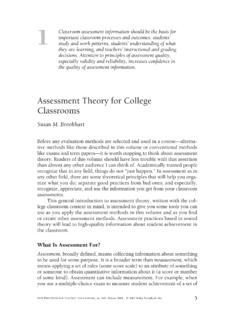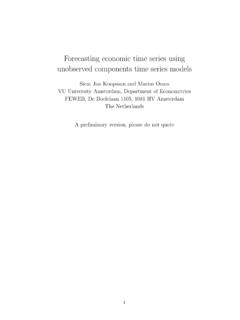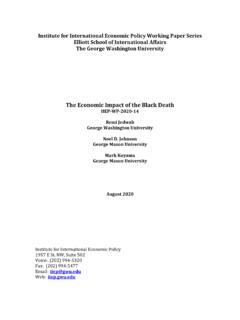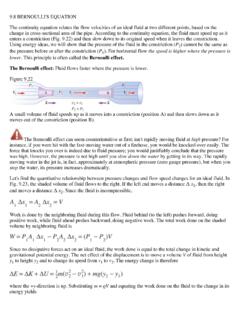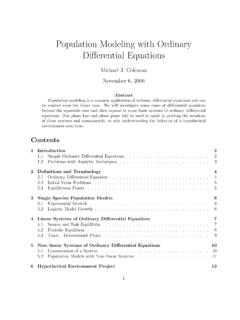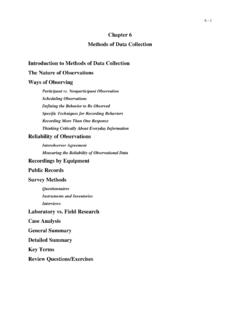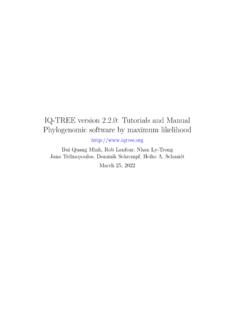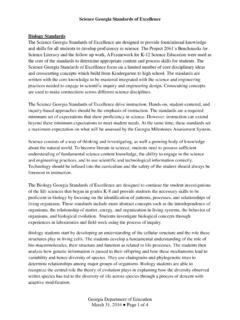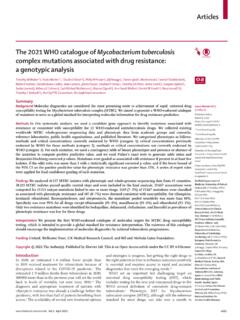Transcription of Basics of Cladistic Analysis - George Washington University
1 Basics of Cladistic AnalysisCopywrite (c) 1998 Diana LipscombGeorge Washington UniversityWashington This guide is designed to acquaint students with the basic principles andmethods of Cladistic Analysis . The first part briefly reviews basic Cladistic methodsand terminology. The remaining chapters describe how to diagnose cladograms,carry out character Analysis , and deal with multiple trees. Each of these topics hasworked hope this guide makes using Cladistic methods more accessible for you andyour students. Report any errors or omissions you find to me and if you copy thisguide for others, please include this page so that they too can contact me. Diana LipscombWeintraub Program in Systematics &Department of Biological SciencesGeorge Washington UniversityWashington 20052 USAe-mail: 1998, D.
2 Lipscomb2 introduction to Systematics All of the many different kinds of organisms on Earth are the result ofevolution. If the evolutionary history, or phylogeny, of an organism is traced back,it connects through shared ancestors to lineages of other organisms. That all of lifeis connected in an immense phylogenetic tree is one of the most significantdiscoveries of the past 150 years. The field of biology that reconstructs this tree anduncovers the pattern of events that led to the distribution and diversity of life iscalled systematics. Systematics, then, is no less than understanding the history of alllife. In addition to the obvious intellectual importance of this field, systematicsforms the basis of all other fields of comparative biology: Systematics provides the framework, or classification, by which otherbiologists communicate information about organisms Systematics and its phylogenetic trees provide the basis of evolutionaryinterpretation The phylogenetic tree and corresponding classification predicts properties ofnewly discovered or poorly known organismsTHE SYSTEMATIC PROCESSThe systematic process consists of five interdependent but distinct steps:1.
3 The taxa to be classified are The characteristics to provide evidence for relationship are The characteristics are analyzed to reconstruct the relationshipamong the taxa (usually in the form of a tree).4. The tree is translated into a formal classification system so that it canbe communicated and used by other scientists. 1998, D. Lipscomb35. The tree is used to test various hypotheses about the process ofevolution in the group. The primary purpose of this booklet is to guide you through step 3. So, for now, wewill skip choosing taxa and characters (steps 1 and 2) and go straight to cladisticanalysis. 1998, D. Lipscomb4 Cladistics or phylogenetic SystematicsGiven that closely related species share a common ancestor and oftenresemble each other, it might seem that the best way to uncover the evolutionaryrelationships would be with overall similarity.
4 In other words, out of a group ofspecies, if two are most similar, can we reasonably hypothesize that they are closestrelatives? Perhaps surprisingly, the answer is no. Overall similarity may bemisleading because there are actually two reasons why organisms have similarcharacteristics and only one of them is due to evolutionary relatedness. When twospecies have a similar characteristic because it was inherited by both from a commonancestor, it is called a homologous feature (or homology). For example, the even-toed foot of the deer, camels, cattle, pigs, and hippopotamus is a homologoussimilarity because all inherited the feature from their common paleodont ancestor. On the other hand, when unrelated species adopt a similar way of life, theirbody parts may take on similar functions and end up resembling one another due toconvergent evolution.
5 When two species have a similar characteristic because ofconvergent evolution, the feature is called an analogous feature (or homoplasy). The paddle-like front limb and streamlined bodies of the aquatic animals shown inthe figure for convergent evolution are examples of analogous homologous similarity is evidence that two species are evolutionarilyrelated. If two animals share the highest number of homologies, can we reasonablyassume they are closest relatives? The answer is still no - a homology may berecently derived or an ancient retained feature; only shared recent homologies(called synapomorphies) are evidence that two organisms are closely related. Anexample will make this point clear: The hand of the first vertebrates to live on landhad five digits (fingers).
6 Many living terrestrial vertebrates (such as humans, turtles,crocodiles and frogs) also have five digits because they inherited them from thiscommon ancestor. This feature is then homologous in all of these species. In 1998, D. Lipscomb5contrast, horses, zebras and donkeys have just a single digit with a hoof. Clearly,humans are more closely related to horses, zebras and donkeys, even though theyhave a homology in common with turtles, crocodiles and frogs. The key point isthat the five digit condition is the primitive state for the number of digits. It wasmodified and reduced to just one digit in the common ancestor of horses, donkeysand zebras. The modified derived state does tell us that horses, zebras and donkeysshare a very recent common ancestor, but the primitive form is not evidence thatspecies are particularly closely related.
7 In an important work (first published in English in 1966) by the Germanentomologist Willi Hennig, it was argued that only shared derived characters couldpossibly give us information about phylogeny. The method that groups organismsthat share derived characters is called cladistics or phylogenetic systematics. Taxathat share many derived characters are grouped more closely together than thosethat do not. The relationships are shown in a branching hierarchical tree called acladogram. The cladogram is constructed such that the number of changes from onecharacter state to the next is minimized. The principle behind this is the rule ofparsimony - any hypothesis that requires fewer assumptions is a more PRIMITIVE (PLESIOMORPHIC) AND DERIVED (APOMORPHIC) CHARACTERSThe first step in basic Cladistic Analysis is to determine which character statesare primitive and which are derived.
8 Many methods for doing this were proposedby Hennig (1966) and others, but the outgroup comparison method is the primaryone in use today. In outgroup comparison, if a taxon that is not a member of thegroup of organisms being classified has a character state that is the same as some ofthe organisms in the group, then that character state can be considered to beplesiomorphic. The outside taxon is called the outgroup and the organisms beingclassified are the ingroup. 1998, D. Lipscomb6 Two arguments can be made to justify using this method: one based on whatwe believe about evolutionary process and the other on logic:1. The only way a homologous feature could be present in both an ingroup and anoutgroup, would be for it to have been inherited by both from an ancestor older thanthe ancestor of just the ingroup:Number of fingersLizardIngroupPlatypusMonkeyKangar ooHorseZebra555115mammal ancestorOutgroupLizardIngroupPlatypusMon keyKangarooHorseZebra555115 Outgroup mammal ancestoramniote ancestor with 5 fingers2.
9 Consider the following example in which a character has states a and b. There areonly two possibilities:1. b is plesiomorphic and a is apomorphicb --> a2. a is plesiomorphic and b is apomorphica --> bIf state a is also found in a taxon outside the group being studied, the firsthypothesis will force us to make more assumptions than the second (it is lessparsimonious): 1998, D. Lipscomb7 Hypothesis 1 ABCOuta-b-babaa-a-Hypothesis 2b-ABCO utbabaIn hypothesis 1, state b is the plesiomorphic state and is placed at the base of the state b only evolved once, it must be assumed that character state a evolved twoseparate times - once in taxon C and once in the Outgroup. In hypothesis 2, state a isthe plesiomorphic state and is placed at the base of the tree. In this hypothesis, bothcharacter states a and b each evolve only once.
10 Therefore, hypothesis 2 is moreparsimonious and is a more defensible hypothesis. This example illustrates whyoutgroup Analysis gives the most parsimonious, and therefore logical, hypothesis ofwhich state is the character has only two states, then the task of distinguishing primitiveand derived character states is fairly simple: The state which is in the outgroup isprimitive and the one found only in the ingroup is derived. It is common practice to designate the primitive states as 0 (zero) and thederived states as 1 (one). If you are going to calculate trees by hand, this willcertainly make your calculations easier. On the other hand, if you are using acomputer program to calculate a tree, it isn t necessary to designate theplesiomorphic state as 0 (zero): 1998, D.
